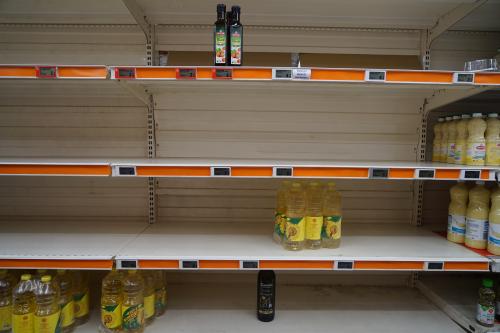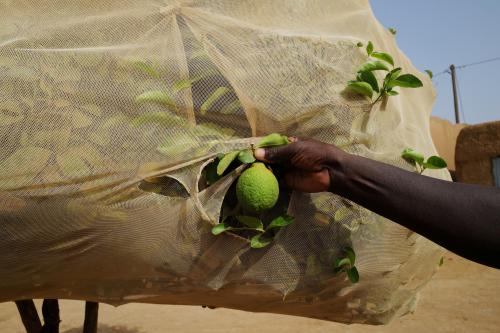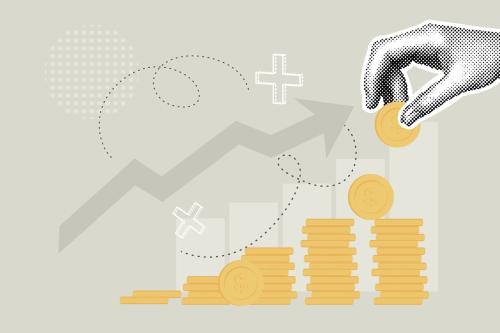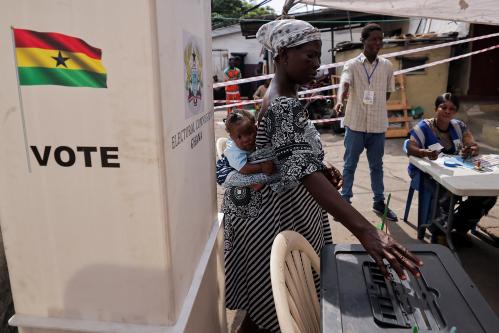The deterioration in the global economic landscape has exacerbated suffering in the world’s poorest countries. Still recovering from the sharp downturn caused by the pandemic, low-income countries (LICs) are being hit hard by soaring inflation at home and rising global interest rates. Dislocations in global commodity markets due to the pandemic, amplified by the war in Ukraine, have led to food and fuel shortages and to surging prices of staple consumer goods. This is eroding real incomes, exacerbating food insecurity, and worsening extreme poverty in LICs. Surging world food prices, which reached their highest levels on record this year, are contributing to the rapid rise in LIC inflation (Figure 1).
Figure 1. Inflation in low-income countries
 Sources: Food and Agriculture Organization of the United Nations (FAO); Haver Analytics; World Bank.
Sources: Food and Agriculture Organization of the United Nations (FAO); Haver Analytics; World Bank.
Note: “Median” line shows median percentage increase in consumer prices from 12 months earlier for a sample of eight low -income countries. Last observation April 2022. The base period prices of the FAO Food Price Index are the averages for the years 2014-2016.
Food insecurity is exacerbating misery
Food consumption accounts for 45 percent of total household expenditure in low-income economies, and diet is heavily based on staple foods including wheat. All LICs are food-deficit countries reliant on imported foods. Imports of wheat from just Russia and Ukraine account for about 14 percent of total caloric intake in a median LIC, compared with just 3 percent in the median emerging market and developing economy. Disruptions to wheat imports from Russia and Ukraine and surging global food prices are slowing LIC growth and increasing extreme poverty, particularly in countries where sizeable segments of the population were already experiencing acute food insecurity (Figure 2).
Figure 2. Wheat imports and food insecurity in LICs
 Sources: Global Network Against Food Crises; Comtrade (database); World Bank.
Sources: Global Network Against Food Crises; Comtrade (database); World Bank.
Note: DRC = Democratic Republic of Congo. Wheat imports shares are averages for 2019-2020; wheat imports data for Sudan is only available for 2018. “People in food crisis” indicates the estimated percentage of population being in phase 3 or above of the Integrated Food Security Phase Classification (IPC) for 2022; estimates are not available for Madagascar and Togo.
Subdued growth and stretched public finances have hamstrung the ability of governments to cushion vulnerable populations from soaring food and fuel prices. Even in LICs that do not rely on imports of wheat from Russia and Ukraine, millions of people are struggling to afford enough food to avoid hunger. Worsening hunger and malnutrition will inevitably exert adverse long-term consequences, compounding the pernicious effects of more than two years of pandemic on human capital.
War-related disruptions and the sharp deceleration in global growth are amplifying other ongoing challenges faced by LICs, including pervasive poverty, deteriorating security, and policy uncertainty. As a result, growth forecasts for 2022 presented in the World Bank’s latest Global Economic Prospects report have been downgraded in more than 80 percent of LICs (Figure 3). Per capita income growth in LICs is projected to be a feeble 1.3 percent this year—well below that in middle-income countries (2.3 percent) and high-income countries (2.4 percent).
Figure 3. Forecast revisions to 2022 growth
 Sources: World Bank.
Sources: World Bank.
Note: EMDEs = emerging market and developing economies; LICs = low-income countries. Sample includes 145 EMDEs and 22 LICs. Forecast revisions show the share of countries where 2022 growth forecasts were downgraded/unchanged/upgraded between January 2022 and June 2022 editions of Global Economic Prospects. Data for 2022 are forecasts.
In commodity-exporting LICs, elevated commodity prices will only partly mitigate the deleterious effects of higher food and fuel costs. In these countries, surging living costs are tempering gains from increased export earnings. High oil prices are also unlikely to boost growth meaningfully in LIC energy exporters, as aging oil fields as well as pandemic-induced maintenance delays and weak extractive investment limit prospects for increased oil production.
Agricultural production in most LICs is also expected to remain subdued, further tightening food supply. Several LICs have faced worsening drought conditions and planting delays due to erratic and poor rainfall. In some LICs, higher prices of grains are expected to limit the ability of farmers, especially those dependent on subsistence agriculture, to purchase enough seeds for the new planting season and feed for livestock. The war in Ukraine has also disrupted the global supply of fertilizers. Insufficient access to agricultural inputs could lead to a state of widespread, low-productivity subsistence farming, rendering LIC food systems more vulnerable to shocks.
More suffering ahead
These sobering prospects could be even weaker if supply shortages, conflict, and divisions persist. With almost all LICs relying on imports of wheat, a longer-lasting disruption to global trade in cereals would worsen affordability and availability of staple foods. Further price increases of farming inputs—such as seeds, fuels, and fertilizers—could lead to worsening food price pressures. These pressures would be particularly painful in LICs where climate change has already depressed productivity in farming and in those with high incidence of extreme poverty. In this environment of high inflation, a more pronounced deterioration in living standards would exacerbate social unrest, especially in countries suffering from high levels of insecurity and violence. As financial conditions tighten, higher risk aversion would lead to increases in borrowing costs in LICs. High levels of public debt and increased non-concessional borrowing could further stall progress in debt relief. About one-fourth of all LIC external debt has variable interest rates, compared to just 11 percent in 2010.
Quick and coordinated responses needed
Already weakened by the adverse shocks during the last two years, LICs are facing stiff headwinds. The scope for domestic fiscal and monetary policy responses is in most cases limited. A concerted global effort is necessary:
- A rapid global response to improve access to safe and nutritious food and bolster food security is critical for health and human development in LICs. The international community needs to substantially scale up financing of LICs’ food systems, including measures that target farming, nutrition, social protection, water, and irrigation.
- LICs also face formidable debt-related challenges. Even before the invasion of Ukraine, about 60 percent of LICs were in or near debt distress. To mitigate the risks that debt burdens lead to financial crises, globally coordinated debt relief efforts are essential.
- The global community also needs to help foster LIC vaccination rates, which continue to lag far behind other EMDEs owing to a combination of insufficient supply, logistical challenges, and vaccine hesitancy. Sustained collective action is required to bolster pandemic preparedness and rapidly expand vaccination campaigns in LICs.
- Finally, the increasing frequency and severity of climate-related disasters highlights the escalating costs of climate change, especially among the poorest countries. Green investment projects need to be accompanied by policies to reduce the economic, health, and social costs of climate change, many of which are borne disproportionately by vulnerable populations in poor economies and make these countries more resilient to climate shocks.
In the poorest countries of the world, a quick return to economic growth and prosperity is the surest antidote to all these problems, including climate change.
The Brookings Institution is committed to quality, independence, and impact.
We are supported by a diverse array of funders. In line with our values and policies, each Brookings publication represents the sole views of its author(s).









Commentary
Food insecurity and economic misery in low-income countries
July 1, 2022